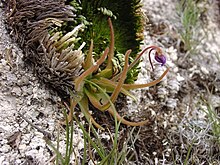Pinguicula gypsicola
| Pinguicula gypsicola | ||||||||||||
|---|---|---|---|---|---|---|---|---|---|---|---|---|

Pinguicula gypsicola |
||||||||||||
| Systematics | ||||||||||||
|
||||||||||||
| Scientific name | ||||||||||||
| Pinguicula gypsicola | ||||||||||||
| Brandegee |
Pinguicula gypsicola is a carnivorous plant belonging to the genus of butterflies ( Pinguicula ).
description

The summer rosette of Pinguicula gypsicola has linear-lanceolate, finely ciliate leaves, 4 to 7, occasionally up to 13 centimeters long. Towards winter it forms a winter rosette with a diameter of only two to four centimeters, which consists of numerous, tiny, almost scale-like leaves. A long-spurred, large, violet-purple flower , which resembles that of a violet, stands on a flower stem that grows up to 17 centimeters high . Pinguicula gypsicola blooms equally from winter and summer rosettes.
The number of chromosomes is 2n = 22.
distribution
Pinguicula gypsicola is a lithophyte that is native to wet, pure gypsum rock in Mexico . The plant is only known from two, about fifty kilometers apart locations in the state of San Luis Potosí . It prefers shady locations that fall completely dry in winter and are exposed to temperatures below 0 ° C and occurs in association with other xerophytes such as Cactaceae , Agave stricta , Selaginella cuspidata , Agave striata , Dasylirion longissimum , Dodonea viscosa and Hechtia glomerata .
Systematics
The species was in 1911 by Townshend Stith Brandegee (1843 to 1925 † *), a California botanist who first described and is in the section Orcheosanthus asked. The specific epithet means something like "living in plaster" and refers to the location.
literature
- S. Jost Casper : Monograph of the genus Pinguicula L. (= Bibliotheca Botanica. H. 127/128, ISSN 0067-7892 ). Swiss beard, Stuttgart 1966.
- Wilhelm Barthlott , Stefan Porembski, Rüdiger Seine, Inge Theisen: Carnivores. Biology and culture of carnivorous plants. Ulmer, Stuttgart 2004, ISBN 3-8001-4144-2 .
Individual evidence
- ^ Pinguicula gypsicola at Tropicos.org. In: IPCN Chromosome Reports . Missouri Botanical Garden, St. Louis